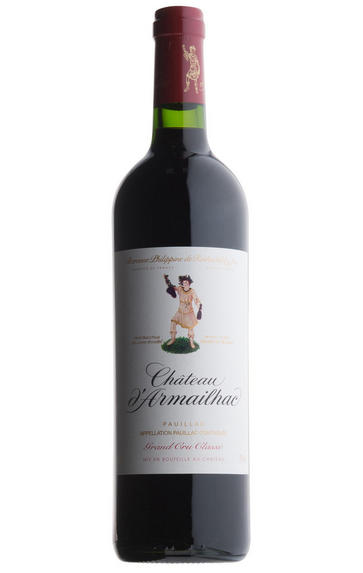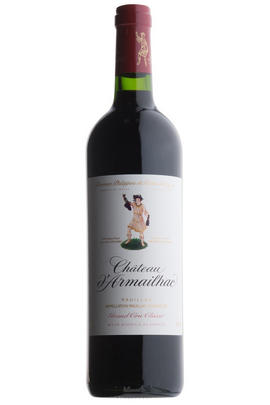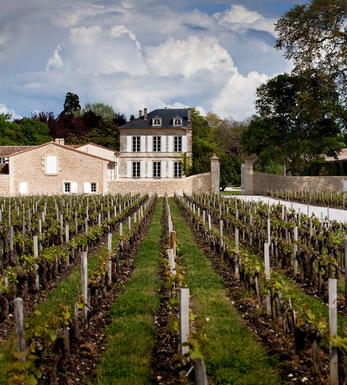
2005 Château d'Armailhac, Pauillac, Bordeaux

Critics reviews
Robert M. Parker, Jr. - 29/06/2015
Robert M. Parker, Jr. - Wine Advocate - eRobertParker.com #219 Jun 2015
About this WINE

Château d'Armailhac
Classified as a Fifth Growth in 1855, Château d’Armailhac came under the ownership of the Baron Philippe de Rothschild family in 1933. Today Baroness Philippine’s children, Camille and Philippe Sereys de Rothschild and Julien de Beaumarchais de Rothschild continue the family’s quest for excellence and innovation in the vineyard and winery.
The 76-hectare estate is managed alongside stablemates Château Mouton Rothschild and Château Clerc Milon; expertise is shared across the properties.
The south-facing vineyard is located in the northern part of Pauillac, adjacent to Château Mouton Rothschild, and is made up of deep, gravelly soil favoured by Cabernet Sauvignon. It’s no surprise, then, that this grape dominates the planting with the rest given over to Merlot (35%), Cabernet Franc (8%) and Petit Verdot (2%). The Cabernet Franc vines, which have an average age of 60 years, derived from ancestral massal selection, make up a relatively high proportion of the blend and are a hallmark of the wine. Harvesting is done by hand, and the grapes are sorted and destemmed.

Pauillac
Pauillac is the aristocrat of the Médoc boasting boasting 75 percent of the region’s First Growths and with Grand Cru Classés representing 84 percent of Pauillac's production.
For a small town, surrounded by so many familiar and regal names, Pauillac imparts a slightly seedy impression. There are no grand hotels or restaurants – with the honourable exception of the establishments owned by Jean-Michel Cazes – rather a small port and yacht harbour, and a dominant petrochemical plant.
Yet outside the town, , there is arguably the greatest concentration of fabulous vineyards throughout all Bordeaux, including three of the five First Growths. Bordering St Estèphe to the north and St Julien to the south, Pauillac has fine, deep gravel soils with important iron and marl deposits, and a subtle, softly-rolling landscape, cut by a series of small streams running into the Gironde. The vineyards are located on two gravel-rich plateaux, one to the northwest of the town of Pauillac and the other to the south, with the vines reaching a greater depth than anywhere else in the Médoc.
Pauillac's first growths each have their own unique characteristics; Lafite Rothschild, tucked in the northern part of Pauillac on the St Estèphe border, produces Pauillac's most aromatically complex and subtly-flavoured wine. Mouton Rothschild's vineyards lie on a well-drained gravel ridge and - with its high percentage of Cabernet Sauvignon - can produce (in its best years) Pauillac's most decadently rich, fleshy and exotic wine.
Latour, arguably Bordeaux's most consistent First Growth, is located in southern Pauillac next to St Julien. Its soil is gravel-rich with superb drainage, and Latour's vines penetrate as far as five metres into the soil. It produces perhaps the most long-lived wines of the Médoc.
Recommended Châteaux
Ch. Lafite-Rothschild, Ch. Latour, Ch. Mouton-Rothschild, Ch. Pichon-Longueville Baron, Ch. Pichon Longueville Comtesse de Lalande, Ch. Lynch-Bages, Ch. Grand-Puy-Lacoste, Ch, Pontet-Canet, Les Forts de Latour, Ch. Haut-Batailley, Ch. Batailley, Ch. Haut-Bages Libéral.

Cabernet Sauvignon Blend
Cabernet Sauvignon lends itself particularly well in blends with Merlot. This is actually the archetypal Bordeaux blend, though in different proportions in the sub-regions and sometimes topped up with Cabernet Franc, Malbec, and Petit Verdot.
In the Médoc and Graves the percentage of Cabernet Sauvignon in the blend can range from 95% (Mouton-Rothschild) to as low as 40%. It is particularly suited to the dry, warm, free- draining, gravel-rich soils and is responsible for the redolent cassis characteristics as well as the depth of colour, tannic structure and pronounced acidity of Médoc wines. However 100% Cabernet Sauvignon wines can be slightly hollow-tasting in the middle palate and Merlot with its generous, fleshy fruit flavours acts as a perfect foil by filling in this cavity.
In St-Emilion and Pomerol, the blends are Merlot dominated as Cabernet Sauvignon can struggle to ripen there - when it is included, it adds structure and body to the wine. Sassicaia is the most famous Bordeaux blend in Italy and has spawned many imitations, whereby the blend is now firmly established in the New World and particularly in California and Australia.


Buying options
Add to wishlist
Description
The château formerly known as Mouton-Baronne-Philippe, but since 1989 called d'Armailhac, is the least known of Baroness Philippine's trio of estates but is arguably the best value. Rich, dark dried fruits and floral hints on the nose are followed by a delicious palate of surprising depth and intensity. Fresh acidity and excellent concentration
of wild berry fruits contributes to the energy of this wine, while the Pauillac earthiness just adds another element to the wine's sexy character
wine at a glance
Delivery and quality guarantee